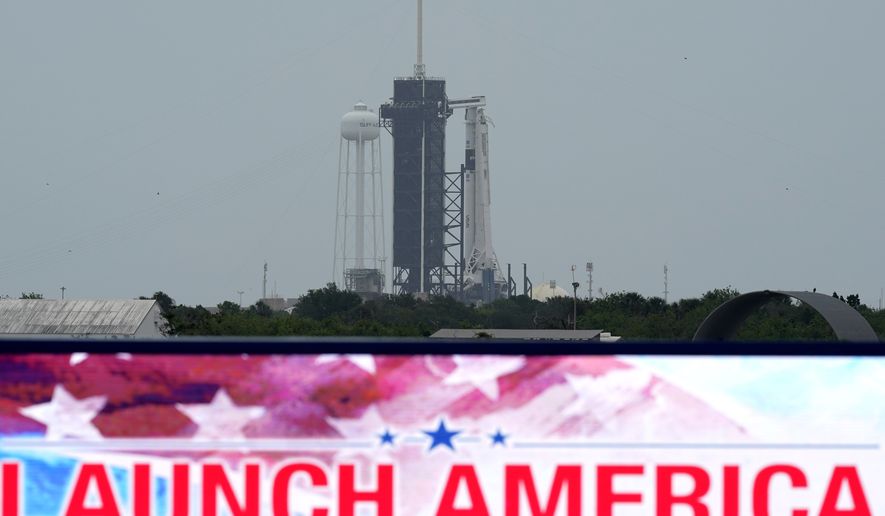OPINION:
Americans were not meant to sit on their hands with their feet up on the coffee table. Our forebears of more than 10 generations took leaps of faith — some by ship, some by foot and some by airplane — all to light upon a new land where they could chase their wildest dreams. A new chapter in the story of the nation’s journey begins Wednesday when a fresh generation of spacecraft, labeled “Made in America,” lifts off from the Kennedy Space Center in Florida. New adventures and opportunities await, somewhere out there.
The Crew Dragon spacecraft set to launch, part throwback, part futuristic, is the product of a partnership between NASA and Elon Musk’s SpaceX enterprise. Astronauts Doug Hurley and Bob Behnken will be nestled in a capsule in the rocket nose cone, similar to the Mercury, Gemini and Apollo vehicles of NASA’s early space launches. But there the similarity ends. The modern model is far more spacious than those earlier versions, with room for seven, and it comes equipped with cutting-edge touch-screen control panels. The vessel has already gone aloft, unmanned, on more than a score of flights ferrying supplies to the space station.
Nearly 10 years have passed since U.S. spacefarers had their wings clipped with the 2011 grounding of the shuttle fleet. Embarrassingly, astronauts have had no way to reach the International Space Station except by paying tens of millions of dollars to hitch a ride with the Russians on their 1960s-era Soyuz module — the equivalent of NASCAR’s Jimmie Johnson calling an Uber after his competition Camaro breaks down on the racetrack.
The space hiatus that ends with a 21st century upgrade wasn’t supposed to keep the United States earthbound this long. With an eye on returning to the moon for practice and then rocketing beyond to Mars, NASA had big plans for a manned vehicle for deep space exploration, dubbed the Constellation. Citing cost overruns, President Obama canceled the program in 2010. Despite the devastating setback, NASA came back a year later with a new scheme, called the Space Launch System, designed to propel a large space capsule, the Orion, on short-haul missions to the moon by 2024 and on to distant Mars by the 2030s.
Where government red tape threatens to strangle progress, private entrepreneurs see opportunity. Mr. Musk’s SpaceX has brought down the cost of supply missions by figuring out how to launch rockets and gently land them for reuse. Under contract with NASA, the company has broken barriers to commercial space transportation by winning contracts for restocking the space station with necessities for its multinational inhabitants. The impending flight is meant to demonstrate the ability to safely ferry human cargo aloft as well.
At the same time, SpaceX is working on its own interplanetary exploration vehicle, dubbed the Starship Human Landing System, for NASA’s use as the lander component in its Artemis moon mission. The company has also tested a super-sized rocket capable of boosting the Starship, placing one of Mr. Musk’s Tesla electric cars in orbit around the sun. Behind the wheel of the red 2008 roadster is a spacesuited mannequin whose left elbow rests casually on the sill of the car’s open window, an example of the owner’s quirky sense of humor. It’s also characteristic of the sort of irrepressible adventurism that has made America the world’s leader in bold innovation.
Others also recognize the opportunities awaiting the commercialization of space. Amazon founder Jeff Bezos is competing for the NASA moon lander contract with his Blue Moon vehicle, a project of this Blue Horizon aerospace company. Together with Richard Branson and his Virgin Galactic enterprise, they, too, are shooting for a share of the coming space tourism industry, which has been stuck on the launch pad for several years awaiting a green light on safety issues.
The coronavirus pandemic that has forced the global economy into a low ebb has likewise throttled what had been until recently a U.S. financial juggernaut. As Americans search their souls for the fortitude to rebuild their wrecked fortunes, they might find what they are looking for by gazing skyward on Wednesday afternoon. When the countdown hits the goose egg, the Crew Dragon will bolt into the heavens on a wing and a prayer, pointing the way toward the highest form of human adventure and proving that the American manned space program is back.




Please read our comment policy before commenting.